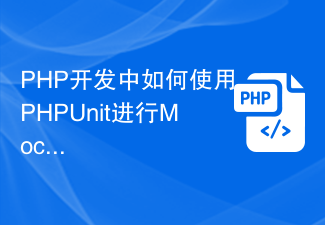 Backend Development
Backend Development PHP Tutorial
PHP Tutorial Implementation of automated testing function of phpunit interface
Implementation of automated testing function of phpunit interfaceThis time I will bring you the implementation of the phpunit interface automated testing function. What are the precautions for the implementation of the phpunit interface automated testing function. The following is a practical case, let's take a look.
I came into contact with phpunit by chance at the beginning of the year, an open source software developed with PHPprogramming language, and also a unit testing framework. If used effectively, the interface can be greatly improved. Traversal efficiency. Not much nonsense, let’s get straight to the point.
1.Install
In the directory of php
pear channel-discover pear; pear install phpunit/PHPUnit
2.Configuration
First create a configuration file stored in the lib folder, then create a new transfer.php file
<?php function do_Post($url, $fields, $extraheader = array()){
$ch = curl_init();
curl_setopt($ch, CURLOPT_URL, $url);
curl_setopt($ch, CURLOPT_POST, true);
curl_setopt($ch, CURLOPT_POSTFIELDS, $fields );
curl_setopt($ch, CURLOPT_HTTPHEADER, $extraheader);
curl_setopt($ch, CURLOPT_RETURNTRANSFER, true); // 获取数据返回
$output = curl_exec($ch);
curl_close($ch);
return $output;
}
function do_Get($url, $extraheader = array()){
$ch = curl_init();
curl_setopt($ch, CURLOPT_URL, $url);
curl_setopt($ch, CURLOPT_HTTPHEADER, $extraheader);
curl_setopt($ch, CURLOPT_RETURNTRANSFER, true); // 获取数据返回:
//curl_setopt($ch, CURLOPT_VERBOSE, true);
$output = curl_exec($ch) ;
curl_close($ch);
return $output;
}
function do_Put($url, $fields, $extraheader = array()){
$ch = curl_init();
curl_setopt($ch, CURLOPT_URL, $url ) ;
curl_setopt($ch, CURLOPT_POST, true) ;
curl_setopt($ch, CURLOPT_CUSTOMREQUEST, 'PUT');
curl_setopt($ch, CURLOPT_POSTFIELDS, $fields );
curl_setopt($ch, CURLOPT_HTTPHEADER, $extraheader);
curl_setopt($ch, CURLOPT_RETURNTRANSFER, true); // 获取数据返回
//curl_setopt($ch, CURLOPT_ENCODING, '');
$output = curl_exec($ch);
curl_close($ch);
return $output;
}
function do_Delete($url, $fields, $extraheader = array()){
$ch = curl_init();
curl_setopt($ch, CURLOPT_URL, $url ) ;
curl_setopt($ch, CURLOPT_POST, true);
curl_setopt($ch, CURLOPT_CUSTOMREQUEST, 'DELETE');
curl_setopt($ch, CURLOPT_POSTFIELDS, $fields);
curl_setopt($ch, CURLOPT_HTTPHEADER, $extraheader);
curl_setopt($ch, CURLOPT_RETURNTRANSFER, true); // 获取数据返回
//curl_setopt($ch, CURLOPT_ENCODING, '');
$output = curl_exec($ch);
curl_close($ch);
return $output;
}Finally create a basetest.php file
<?php
require_once("transfer.php");
define("PREFIX", "http://xxx");
define("HTTPSPREFIX", "https://xxx");
function build_get_param($param) {
return http_build_query($param);
}The interface test environment is now set up.
3. Write test cases
<?php $basedir = dirname(FILE);
require_once($basedir . '/lib/basetestdev.php');
define("PHONE", "xxx");
define("PWD", "xxx");
define("POSTURL","xxx");
class TestAPI extends PHPUnit_Framework_TestCase {
private function call_http($path, $param, $expect = 'ok') {
$_param = build_get_param($param);
$url = PREFIX . "$path?" . $_param;
$buf = do_Get($url);
$obj = json_decode($buf, True);
$this->assertEquals($obj['retval'], $expect);
return $obj;
}
private function call_https($path, $param, $expect = 'ok') {
$_param = build_get_param($param);
$url = HTTPSPREFIX . "$path?" . $_param;
$buf = do_Get($url);
$obj = json_decode($buf, True);
$this->assertEquals($obj['retval'], $expect);
return $obj;
}
public function testLogin(){
$param = array(
'type' => 'phone'
,'token' => PHONE
,'password' => PWD
);
$url = 'login';
return $this->call_http($url, $param);
}
/**
* @depends testLogin
*/
public function testInfo(array $user){
$session = $user['retinfo']['session'];
$param = array(
'session' => $session
);
$url ='info';
return $this->call_http($url, $param);
}If it is a post request
public function testPost(){
$session = $user['retinfo']['sessionid'];
$param = array(
,'data' => '111'
);
$url = POSTURL.'posturl';
return do_POST($url,$param);
}I believe you have read it You have mastered the method in the case of this article. For more exciting information, please pay attention to other related articles on the php Chinese website!
Recommended reading:
ThinkPHP implements WeChat payment (jsapi payment) process tutorial detailed explanation_php example
PHP’s WeChat refund application
The above is the detailed content of Implementation of automated testing function of phpunit interface. For more information, please follow other related articles on the PHP Chinese website!
 PHP开发中如何使用PHPUnit进行Mock测试Jun 27, 2023 am 10:25 AM
PHP开发中如何使用PHPUnit进行Mock测试Jun 27, 2023 am 10:25 AM在PHP开发中,测试是非常重要的一个环节,测试可以大大减少错误的发生,提高代码质量。Mock测试是测试中的一种形式,它可以模拟出虚假的对象或数据,以便测试我们代码的某个特定功能或场景。PHPUnit是PHP中非常流行的一个测试框架,它支持Mock测试。在这篇文章中,我们将探讨如何使用PHPUnit进行Mock测试。一、什么是Mock测试在开始之前,我们先来了
 PHP中的测试报告工具May 24, 2023 am 08:24 AM
PHP中的测试报告工具May 24, 2023 am 08:24 AMPHP是一种常见的开源编程语言,广泛应用于Web开发中,它的优点就在于易学、易用、可拓展性强等优点。而作为开发者,我们为了在保证代码质量的同时提高开发效率,必不可少的就是测试和测试报告的使用。在PHP开发中,有很多测试和测试报告工具,其中最常见的就是PHPUnit。然而,PHPUnit虽然简单易用,但是需要一些编写测试用例的基础知识,如果不熟悉,使用起来还是
 php怎么设置implode没有分隔符Apr 18, 2022 pm 05:39 PM
php怎么设置implode没有分隔符Apr 18, 2022 pm 05:39 PM在PHP中,可以利用implode()函数的第一个参数来设置没有分隔符,该函数的第一个参数用于规定数组元素之间放置的内容,默认是空字符串,也可将第一个参数设置为空,语法为“implode(数组)”或者“implode("",数组)”。
 PHP中的代码检查工具May 24, 2023 pm 12:01 PM
PHP中的代码检查工具May 24, 2023 pm 12:01 PM检查代码质量是每个程序员都必须要做的任务,而PHP中也有很多工具可以用于检查代码的质量和风格,从而提高代码的可读性和可维护性,提高代码的可靠性和安全性。本文将介绍几种常见的PHP代码检查工具,并对它们进行简单的比较和评估,希望可以帮助读者在开发过程中选择合适的工具,提高代码质量和效率。PHP_CodeSnifferPHP_CodeSniffer是一个广泛应用
 php如何使用PHPUnit和Mockery进行单元测试?May 31, 2023 pm 04:10 PM
php如何使用PHPUnit和Mockery进行单元测试?May 31, 2023 pm 04:10 PM在PHP项目开发中,单元测试是一项很重要的任务。PHPUnit和Mockery是两个相当流行的PHP单元测试框架,其中PHPUnit是一个被广泛使用的单元测试工具,而Mockery则是一个专注于提供统一而简洁的API以创建和管理对象Mock的对象模拟工具。通过使用PHPUnit和Mockery,开发人员可以快速高效地进行单元测试,以确保代码库的正确性和稳定性
 PHP编程中有哪些常见的代码质量工具?Jun 12, 2023 am 08:16 AM
PHP编程中有哪些常见的代码质量工具?Jun 12, 2023 am 08:16 AMPHP编程中有哪些常见的代码质量工具?在现代的软件开发中,代码质量是非常重要的。如果代码质量不好,不仅会降低代码的可读性,增加维护难度,还会造成安全漏洞等一系列问题。而在PHP编程中,我们可以使用一些代码质量工具来检查代码的质量。本文将介绍一些常见的PHP代码质量工具。PHP_CodeSnifferPHP_CodeSniffer是一个用于静态分析PHP代码的
 如何使用PHP和PHPUnit检查代码规范和质量Jun 25, 2023 pm 04:57 PM
如何使用PHP和PHPUnit检查代码规范和质量Jun 25, 2023 pm 04:57 PM在现代的软件开发中,代码质量和规范是极为重要的因素。不仅可以让代码更加整洁易于维护,还可以提高代码的可读性和可扩展性。但是,如何检查代码的质量和规范呢?本文将介绍如何使用PHP和PHPUnit来实现这一目标。第一步:检查代码规范在PHP开发中,有一种非常流行的代码规范,它被称为PSR(PHP标准规范)。PSR规范的目的是使PHP代码更具可读性和可维护性。其中
 如何使用PHPUnit进行PHP单元测试May 12, 2023 am 08:13 AM
如何使用PHPUnit进行PHP单元测试May 12, 2023 am 08:13 AM随着软件开发行业的发展,测试逐渐成为了不可或缺的一部分。而单元测试作为软件测试中最基础的一环,不仅能够提高代码质量,还能够加快开发者开发和维护代码的速度。在PHP领域,PHPUnit是一个非常流行的单元测试框架,它提供了各种功能来帮助我们编写高质量的测试用例。在本文中,我们将介绍如何使用PHPUnit进行PHP单元测试。安装PHPUnit在使用PHPUnit


Hot AI Tools

Undresser.AI Undress
AI-powered app for creating realistic nude photos

AI Clothes Remover
Online AI tool for removing clothes from photos.

Undress AI Tool
Undress images for free

Clothoff.io
AI clothes remover

AI Hentai Generator
Generate AI Hentai for free.

Hot Article

Hot Tools

Dreamweaver Mac version
Visual web development tools

SublimeText3 Chinese version
Chinese version, very easy to use

SAP NetWeaver Server Adapter for Eclipse
Integrate Eclipse with SAP NetWeaver application server.

Safe Exam Browser
Safe Exam Browser is a secure browser environment for taking online exams securely. This software turns any computer into a secure workstation. It controls access to any utility and prevents students from using unauthorized resources.

VSCode Windows 64-bit Download
A free and powerful IDE editor launched by Microsoft





